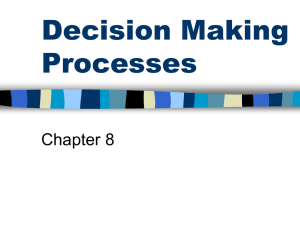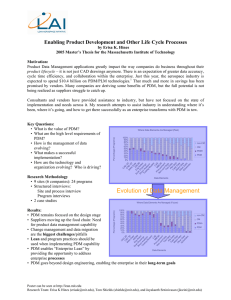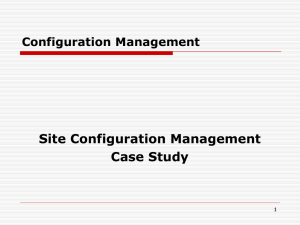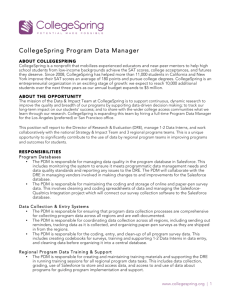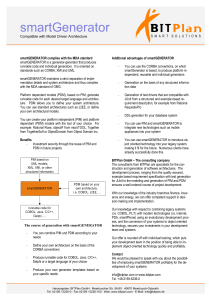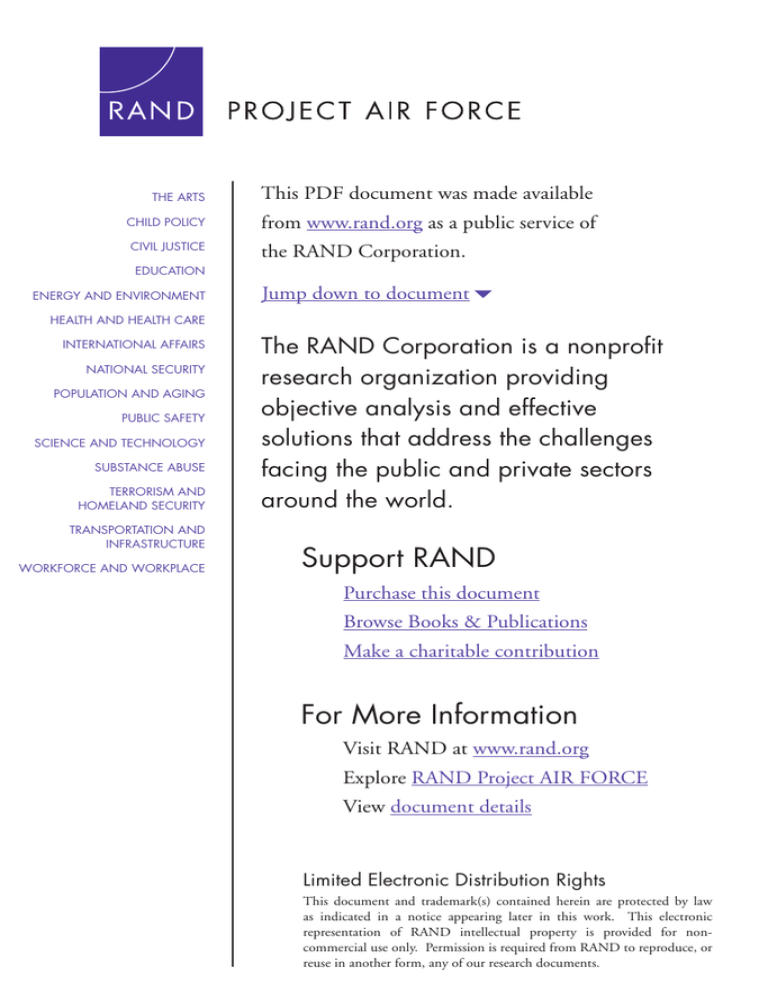
THE ARTS
This PDF document was made available
CHILD POLICY
from www.rand.org as a public service of
CIVIL JUSTICE
the RAND Corporation.
EDUCATION
ENERGY AND ENVIRONMENT
Jump down to document6
HEALTH AND HEALTH CARE
INTERNATIONAL AFFAIRS
NATIONAL SECURITY
POPULATION AND AGING
PUBLIC SAFETY
SCIENCE AND TECHNOLOGY
SUBSTANCE ABUSE
TERRORISM AND
HOMELAND SECURITY
TRANSPORTATION AND
INFRASTRUCTURE
WORKFORCE AND WORKPLACE
The RAND Corporation is a nonprofit
research organization providing
objective analysis and effective
solutions that address the challenges
facing the public and private sectors
around the world.
Support RAND
Purchase this document
Browse Books & Publications
Make a charitable contribution
For More Information
Visit RAND at www.rand.org
Explore RAND Project AIR FORCE
View document details
Limited Electronic Distribution Rights
This document and trademark(s) contained herein are protected by law
as indicated in a notice appearing later in this work. This electronic
representation of RAND intellectual property is provided for noncommercial use only. Permission is required from RAND to reproduce, or
reuse in another form, any of our research documents.
This product is part of the RAND Corporation monograph series.
RAND monographs present major research findings that address the
challenges facing the public and private sectors. All RAND monographs undergo rigorous peer review to ensure high standards for
research quality and objectivity.
Programmed Depot
Maintenance Capacity
Assessment Tool
Workloads, Capacity, and Availability
Elvira N. Loredo, Raymond A. Pyles, Don Snyder
Prepared for the United States Air Force
Approved for public release; distribution unlimited
The research described in this report was sponsored by the United States
Air Force under Contract F49642-01-C-0003 and FA7014-06-C-0001.
Further information may be obtained from the Strategic Planning
Division, Directorate of Plans, Hq USAF.
Library of Congress Cataloging-in-Publication Data
Loredo, Elvira N.
Programmed depot maintenance capacity assessment tool : workloads, capacity,
and availability / Elvira N. Loredo, Raymond A. Pyles, Don Snyder.
p. cm.
Includes bibliographical references.
ISBN 978-0-8330-4015-2 (pbk. : alk. paper)
1. KC-135 (Tanker aircraft)—Maintenance and repair—Costs—Evaluation.
I. Pyles, Raymond, 1941– II. Snyder, Don, 1962– III. Title.
UG1242.T36L68 2007
358.4'4—dc22
2006102497
The RAND Corporation is a nonprofit research organization providing
objective analysis and effective solutions that address the challenges
facing the public and private sectors around the world. RAND’s
publications do not necessarily reflect the opinions of its research clients
and sponsors.
R® is a registered trademark.
© Copyright 2007 RAND Corporation
All rights reserved. No part of this book may be reproduced in any
form by any electronic or mechanical means (including photocopying,
recording, or information storage and retrieval) without permission in
writing from RAND.
Published 2007 by the RAND Corporation
1776 Main Street, P.O. Box 2138, Santa Monica, CA 90407-2138
1200 South Hayes Street, Arlington, VA 22202-5050
4570 Fifth Avenue, Suite 600, Pittsburgh, PA 15213-2665
RAND URL: http://www.rand.org/
To order RAND documents or to obtain additional information, contact
Distribution Services: Telephone: (310) 451-7002
Fax: (310) 451-6915; Email: order@rand.org
Summary
Aging Air Force fleets have accrued material deterioration problems
that have resulted in increasing maintenance workloads, which have, in
turn, led to reduced availability of the fleets for operations and training.
Nowhere has this problem been more apparent and severe than during
the periodic inspection and repair of aircraft structural elements of
PDM (see pp. 5–8).
PDM is conducted in large organic or contractor facilities where
aircraft can be partially disassembled, inspected, and repaired. A typical PDM visit may require between 2,000 and 50,000 labor hours
(depending on the fleet) and substantial material. The total labor
required to complete PDM is expected to increase as a function of the
age of the fleet. However, there are different perspectives on the form
that this increase may take. One analytic community (which we refer
to as the engineers) relies on engineering judgment and current planned
workloads to theorize that future workloads might stabilize over the
near term; another group (the statisticians) rely on statistically based
cost and workload trends to theorize that workloads and costs will
grow and that availability will decrease.
Traditional Modeling Approaches Have Limited
Applicability
While detailed resource and process simulation models can be constructed for a specific facility at a specific point in time, the workload,
processes, and resource availabilities change constantly. More prob-
xv
xvi
Programmed Depot Maintenance Capacity Assessment Tool
lematic, the specific workflows used by competing entities (organic or
contractor) are seen as a proprietary matter that affects their ability to
compete for future workloads. As a consequence, few facilities are willing to share detailed information on their specific work processes.
We developed PDMCAT to be able to estimate the number of
aircraft in PDM status, future inductions, and production levels and to
rely only minimally on detailed information from inside a facility (see
pp. 9–12). We also sought to rely on easily observable features, such as
the number of docks for performing maintenance and recent measures
of actual performance, so that having “inside” information was not
critical to forecasts of future inductions or numbers of aircraft in PDM
status (i.e., not available for operations and training).
To that end, we extended and elaborated the BJB model (Zahorjan
et al., 1982) to include multiple servers within each job stage. The
original model was developed for the operational design of computing
time-sharing systems. Appendix A discusses queuing theory related to
this model. The BJB model required very little information in the first
place, and we were able to simplify its data requirements further and
apply it to the PDM process. Chapter Three describes application of
the model and its development; Appendix B presents more detail on
our extension.
Testing and Demonstrating PDMCAT: The KC-135 Case
To test and demonstrate the model’s capabilities, we applied it to the
KC-135 PDM process described in Chapter Four, first examining how
well the model was able to forecast recent PDM performance, then
comparing two alternative forecasts of the future workload and evaluating capacity and PDM process-improvement options to maintain
acceptable availability levels. That fleet was chosen because there was
an ample amount of information about its recent workloads, number of
aircraft in PDM status, and changing capacity. More important, that
fleet had experienced a substantial change in the number of aircraft
in PDM status during the years 1998–2002, so we believed it would
Summary
xvii
constitute a good test of the PDMCAT model’s forecasting capabilities
(see pp. 13–22).
The alternative forecasts reflected engineers’ versus statistical
workload predictions. The fleet reduction program example demonstrates how changes in fleet size would reduce the number of aircraft
in PDM status as the number of aircraft inducted each year diminishes. Figure S.1 shows the aircraft purpose possession history of the
KC-135 tanker fleet from the second quarter of fiscal year 1995 to the
first quarter of fiscal year 2004.3 This chart shows the increase in the
so-called depot-possessed aircraft and the consequential decrease in that
Figure S.1
Changes in Depot Capacity and Required Workload Created a Bubble in
Depot-Possessed Aircraft
600
Number of KC-135 aircraft
500
Test and training
Available for operation
Depot field team
Contractor depot
Organic depot
400
300
200
100
0
qt2
1995
qt2
1996
qt2
1997
qt2
1998
qt2
1999
qt2
2000
qt2
2001
qt2
2002
qt2
2003
Date (end of fiscal quarter [qt])
RAND MG519-S.1
3
The aircraft purpose possession history indicates how many Air Force aircraft are possessed for different purposes (e.g., test, training, modification, maintenance). It is constructed from detailed daily possession status change reports for each aircraft serial number.
Most important for this study, it contains information from which one can compute the
historical number of aircraft in PDM status and the number that entered PDM each year.
xviii
Programmed Depot Maintenance Capacity Assessment Tool
aircraft’s availability for operations starting in the third quarter of 1997
and peaking in the second quarter of 1999—with almost 200 KC-135
tankers either in possession of depot field teams or at organic or contractor depot facilities. Our initial analyses addressed the PDMCAT
model’s ability to replicate that experience.
Initial Analysis of the PDMCAT Model
We used historical workload data to compare the model’s forecasts to
actual aircraft in PDM status during a critical transition period—from
1997 through 2003. During this time, the number of aircraft in PDM
status increased by more than 50 percent, then returned to levels below the
initial 1997 level. Figure S.2 shows that the PDMCAT model accurately
reflected the increase and subsequent decrease in aircraft in PDM status.
Figure S.2
PDMCAT Forecasts Using Actual Workloads Match Actual In-Work Forecasts
Using the PDMCAT Model
Number of KC-135 aircraft in PDM status
140
120
100
80
60
40
Actual
Forecast
20
0
Sep
1996
Sep
1997
Sep
1998
Sep
1999
Sep
2000
Date
RAND MG519-S.2
Sep
2001
Sep
2002
Sep
2003
Sep
2004
Summary
xix
Using the PDMCAT Model to Assess Assumptions About
Future Operations
Finding the historical match acceptable, we applied the model to test
how assumptions about workload plans, induction schedules, labor
application rates (often called burn rates), depot capacity, and fleet size
would affect the forecast of near- and long-term inductions, production quantities, and aircraft in PDM status. A sample of how we used
PDMCAT to test various assumptions is shown below.
Forecast of Future Workloads
Two forecasts of future PDM workloads were used in the Chapter
Four analyses. The first, developed by the KC-135 Economic Service Life
Study (ESLS) (Sperry et al., 2001), uses both statistical analysis and
expert engineering judgment to estimate the effect of fatigue cracking and corrosion growth on future PDM workloads. The second is a
purely statistical equation drawn from a PAF study that sought to discover and characterize maintenance life-cycle workload patterns that
were common across all Air Force fleets, rather than a pattern that may
reflect some idiosyncratic temporary behavior in a single fleet’s history
(Pyles, 2003). (See pp. 18–21.)
We used the model to examine both near-term (one to five years)
and long-term PDM performance. In the near-term cases, we assumed
there was only limited opportunity to increase PDM capacity, but that
the PDM induction policy (i.e., the interval between subsequent PDMs)
could be used to manage the workflow and aircraft availability. In the
long-term cases, we assumed that it would be possible to add physical
capacity (docks where aircraft could receive PDM maintenance) and to
introduce process improvements that could increase the labor application rate (the number of labor hours that can be usefully applied to a
single aircraft in a single day). (See pp. 21–24.)
xx
Programmed Depot Maintenance Capacity Assessment Tool
Using PDMCAT to Moderate the Effects of Changes in
Aircraft Induction Intervals on Near-Term Work in Process
The KC-135 fleet PDM process has experienced a turbulent period
during which previously stable flow times and production rates were
disrupted by a period of low production outputs followed by a period
of higher-than-usual production outputs. If the KC-135 PDM managers were to follow Air Force Technical Order (AFTO) 00-25-4 (U.S.
Air Force, 2003) interval prescriptions exactly, those production fluctuations would reappear as induction fluctuations, creating an imbalance between depot capacity and incoming workload requirements
(see pp. 26–29). PDM managers have some leeway in adjusting aircraft
induction intervals. This was the case in 2002 and 2003, when we
found that the depot inducted five more (in 2002) and 28 more (in
2003) aircraft than required by AFTO 00-25-4 (see U.S. Air Force,
2003).
Figure S.3 shows how we used the PDMCAT model, along with
the PAF workload forecast, to demonstrate the effect of those early
inductions on aircraft in PDM status in subsequent years. Over the
near term, the model projects a temporary reduction in the number of
aircraft in PDM status, followed by an equally temporary increase in
that number that would begin to approach the peak number of aircraft
in PDM status from 1997 through 2003. The later increase was caused
by a forecast increase in PDM workload coinciding with the scheduled
return to PDM of the additional aircraft produced in 2003–2004. By
adjusting the annual induction rates during these periods, we were able
to use the model to identify an alternative induction plan that would
reduce the peak number of aircraft in PDM status to acceptable levels
through 2009.
Using PDMCAT to Test Assumptions About Long-Term
Workload Growth, Increases in Capacity, and Burn Rates
Looking to the long term, which is depicted in Figure S.4, we found
that the more pessimistic PAF workload projection would cause the
depot flow times to increase until the “aircraft in PDM” status would
Summary
xxi
Figure S.3
PDMCAT Near-Term Forecasts Modulated by Changing Inductions
Number of KC-135 aircraft in PDM status
140
120
100
80
60
40
20
0
1995
2002–2003 early
inductions
2004–2008 smoothed
inductions
2000
2005
2010
Fiscal year
RAND MG519-S.3
reach the 1997 to 2003 peak by 2013. We then increased either the
physical capacity (number of docks where maintenance can be performed) or the labor application rate (a composite factor reflecting both
labor available across all shifts and the degree of parallel operations in
the PDM process) by 50 percent in 2010 to evaluate how those capacity increases might change the availability forecast. We learned that
the increases both reduced the number of aircraft in PDM status and
prolonged the time until the 1997 to 2003 surge peak was reached.
The labor application rate option performed better, not reaching the
1997 to 2003 peak until 2024, compared to 2020 for the capacity
increase case. We next examined the implications of the ESLS engineering-based workload forecast, which yielded a much more optimistic long-term outcome, never quite reaching the 1997 to 2003 peak (see
pp. 32–43).
xxii
Programmed Depot Maintenance Capacity Assessment Tool
Figure S.4
Adding Capacity and Increasing the Labor Burn Rate Delay Impact of PAF
Workload Forecast
550
Number of KC-135s in PDM status
500
PAF forecast
50% capacity increase
50% burn-rate increase
ESLS forecast
450
400
350
300
250
200
150
100
50
0
1995
2000
2005
2010
2015
2020
2025
2030
2035
2040
Fiscal year
RAND MG519-S.4
Using PDMCAT to Forecast the Effect of Changes in Fleet
Size
In Chapter Five, we compared the PAF forecast against the KC-135
system program director’s (SPD’s) engineering-based forecast (see
p. 20), assuming that the Air Mobility Command (AMC) plan to
retire KC-135Es would have been implemented until only 490 aircraft
remain in the fleet: 417 KC-135R/Ts and 73 KC-135Es.4 We further
assumed that the capacity would change in proportion to changes in
the projected workloads (see pp. 47–49). With the KC-135 Tanker Sustainment Group’s moderate forecast of PDM workloads, the PDMCAT
4
This plan was not implemented, but the analysis sheds light on how it would have affected
KC-135 aircraft availability.
Summary
xxiii
model projects that the aircraft in PDM will not reach the 100-aircraft level until after 2050.5 Under the less optimistic PAF forecast,
the PDMCAT model projects that the number of aircraft in PDM
status will reach 100 as early as 2013, even if the fleet size is reduced as
planned. This projection is contrasted with the results shown in Figure
S.5 (PAF forecast 1). The conjunction of reducing the KC-135 inventory and increasing capacity significantly reduces the effect of increased
workloads on aircraft availability.
Figure S.5
Reducing KC-135 Inventory and Increasing Capacity Dampen Surge in
Aircraft in Work
Number of KC-135 aircraft in PDM status
200
150
100
PAF forecast 1
PAF forecast
SPD forecast
50
0
2005
2015
2025
2035
2045
2055
2065
Fiscal year
RAND MG519-S.5
5
The office’s formal designation has recently been changed from the KC-135 SPD office to
the 437th Tanker Sustainment Group (437 TSG). The forecast was very similar to that for
the KC-135 ESLS but was based on more-recent decisions that eliminated some near-term
tasks and postponed others.
xxiv
Programmed Depot Maintenance Capacity Assessment Tool
Limitations of the PDMCAT Model
PDMCAT is a macro-level forecasting model. As with all forecasting
models, it is sensitive to the accuracy of the factors used to generate the
forecast. PDMCAT requires three critical factors: a forecast of future
workloads, an estimate of the maximum labor application rate, and an
estimate of the depot capacity.
Future PDM workloads are the subject of some debate. Pyles
(2003) found a general cross-fleet pattern for PDM growth as fleets age
and a significant second-order term related to age. An analysis focused
solely on the KC-135—the KC-135 ESLS (Sperry et al., 2001)—also
projected continued growth on KC-135 PDM workloads, although at a
less pronounced rate than that found by Pyles. The 437 TSG workload
forecast closely mirrors the ESLS forecast in terms of rate of growth,
but projects fewer hours per PDM. The PDMCAT forecast of aircraft
in work will vary depending on the workload forecast used. While
workloads have grown in recent years, this is hardly conclusive evidence that the trend will continue into the future. Some argue that
the workload growth will necessarily taper off as all or most of the key
components on the KC-135 are repaired or replaced. Therefore, users
of the PDMCAT model to forecast long-term trends in aircraft availability (20 or 30 years into the future) should periodically review and
refine the available workload forecasts to reflect more-recent information that may reduce those differences in workload forecasts (see pp.
46–49).
An estimate of the maximum labor application rate (sometimes
called the maximum hands-on burn rate), the rate at which labor can be
applied to PDM workload, may change over time as process improvements, learning, and technology allow depot personnel to work more
efficiently. As it becomes possible to apply more labor simultaneously
to each aircraft, the PDM flow times will diminish. However, some
changes in the underlying processes, such as subcontracting some tasks
to outside entities, may reduce both the measured workload and the
measured maximum labor application rate without necessarily reducing the flow time as the PDM process waits for the completion of subcontracted work. When workloads are contracted out or otherwise
Summary
xxv
moved from the formal PDM package, it is important to reestimate the
labor application rate. As an estimate of depot capacity, the PDMCAT
model measures depot capacity in docks—the number of aircraft that
can receive work simultaneously at the maximum labor rate. The modeler has the option of entering a constant number of docks or of increasing the number of available docks over time. However, the PDMCAT
model does not assess how the addition of docks may change the labor
skill mix and affect the burn rate, nor does it consider how additional
docks are added. That is, PDMCAT does not differentiate the addition
of docks within an existing facility (by freeing up space currently occupied by other workloads) from the addition of docks by hiring contractors or by otherwise increasing physical capacity.
Although the underlying mathematics of the PDMCAT model
support both lower- and upper-bound calculations on PDM throughput, the model produces only an estimate of the upper bound. Estimating the lower bound requires additional information about the imbalances across various stages of the PDM processes (i.e., the times and
resources devoted to different PDM tasks) that would seldom be available to an external observer because of the competitive value of that
information. In addition, we assume that PDM process managers will
allocate their resources across those tasks to maintain a balanced production process, in which the average throughput rates at each production stage are roughly equal.
Conclusions
We were able to use the model to examine some important near- and
long-term issues associated with the KC-135 fleet. While we were
impressed with the model’s existing capabilities, we have already begun
to extend it to deal with multiple fleets using shared facilities, fleets
with induction periods of less than a year, and modification workloads
(see pp. 56–57).
With regard to the KC-135, we found that the shapes of the availability and cost forecasts did not grow in proportion to workloads, as
xxvi
Programmed Depot Maintenance Capacity Assessment Tool
assumed in many studies.6 Future studies forecasting PDM costs and
aircraft availability may need to consider using PDMCAT or equivalent calculations to estimate how changing PDM workloads will affect
fleets’ budgets and availability (see pp. 53–55).
6
The KC-135 Analysis of Alternatives study (Kennedy et al., 2006) is an exception. A version of PDMCAT was used to estimate the number of aircraft in PDM and modification
status, and the PDM costs associated with several different workload forecasts.

